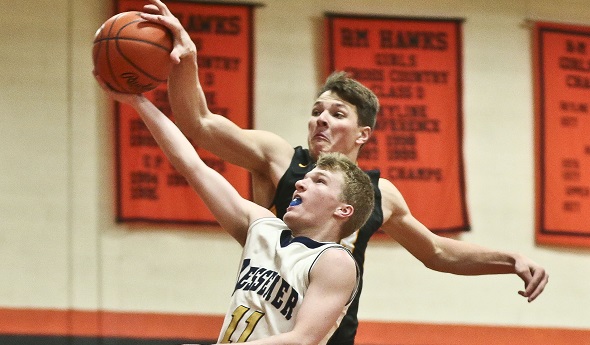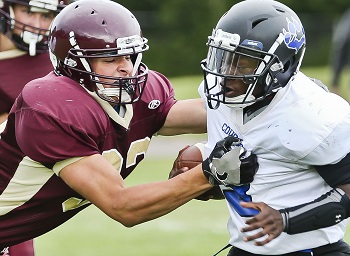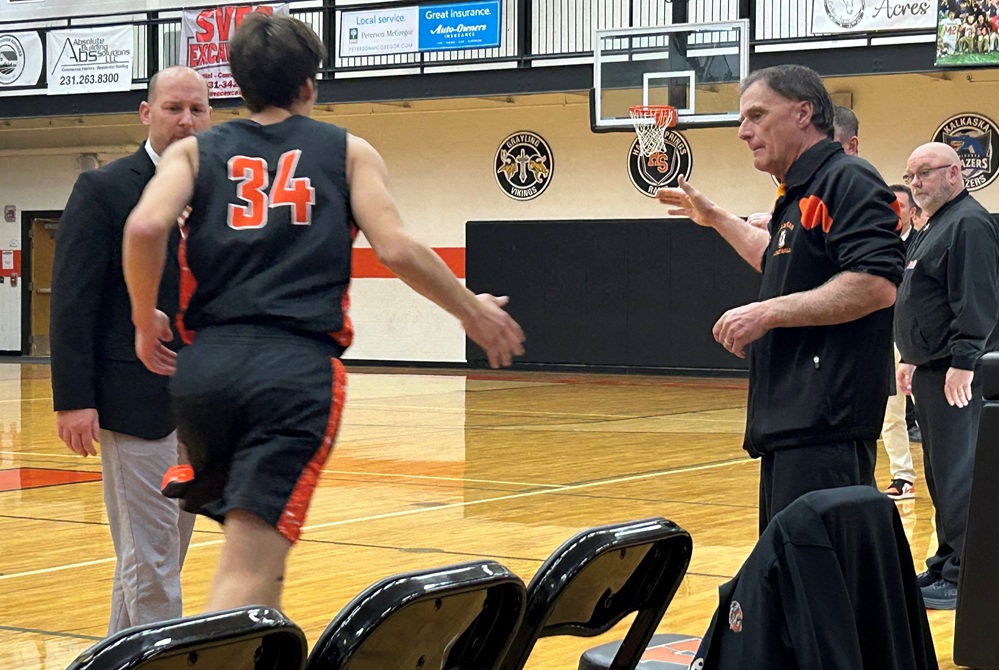
Jake Witt: the UP's Best-Kept Secret
December 22, 2017
By Dennis Grall
Special for Second Half
ESCANABA – You would think it difficult to be a 6-foot-7 athlete and weigh 235 pounds and not be known outside your home area.
 It can happen. And it did happen.
It can happen. And it did happen.
Jake Witt has basically flown beneath the radar of high school sports aficionados heading into the final months of his high school career. That despite the fact he is perhaps the premier senior athlete in Michigan's Upper Peninsula and among the best in the state.
The Ewen-Trout Creek senior has scored more than 1,000 points and is close to 1,000 rebounds in basketball. He is a two-time 8-player all-state football selection, earning those honors after the only two seasons he played football.
He lives about 10 miles from tiny Ewen, where E-TC is located on M-28 about 55 miles from the peninsula's western border with Wisconsin. His school has fewer than 100 students and plays basketball against mostly similar-sized schools from its side of the U.P.
Only a handful of colleges even knew about him, in either sport, primarily because of location and the fact he did not participate in the travel ball circuit. Michigan Tech University, about 70 miles north of his home, knew all about him and offered him a basketball scholarship. Witt signed his letter of intent this fall.
Northern Michigan University, about 110 miles east in Marquette, was in football contact with him before basketball got on board. NMU's basketball team was Witt's second choice behind Tech, where he had participated in some team camps.
Wisconsin-Green Bay was the lone Division I school on his trail, although Northwestern University showed some initial interest. Ferris State and Grand Valley State – which play in the Great Lakes Intercollegiate Athletic Conference with Tech and NMU – also were interested.
"It was nice not having as much attention and having a low profile," Witt said a day after the Panthers beat Bessemer 63-59 last week to raise their record to 4-0 this season. "It was nice playing on a team that does not have much hype. I can just go out and play."
Despite the low profile, it is surprising he escaped notice on the recruiting trail. After all, how many players his size run the 40-yard dash in 4.8 seconds, are used as the primary ball handler on the press break, shoot 3-point field goals with 50 percent accuracy and dominate inside despite constant double- and triple-team defenses?
"He is a big-time athlete, a big-time performer in the U.P.," said veteran Tech coach Kevin Luke. "He is bigger, faster and stronger than anybody up here."
With that pedigree, it is surprising Witt escaped attention of the major schools, although the U.P. is far from even the outlying recruiting paths and not known as a breeding ground for high-caliber cagers – and Witt has not played in Lower Michigan or Wisconsin.
"If he played just one summer of AAU ball (or played downstate) he would have had a ton of Division I schools after him," said E-TC coach Brad Besonen, adding "his location and not advertising himself" were factors in his lack of attention.
Witt had an opportunity to join a travel team in Escanaba, but declined because of six-hour round-trip drives for practice on Wednesday and Sunday nights in addition to lengthy travel for games. "It was mainly my location," he said of avoiding travel teams.
The colleges that did not chase Witt may have missed someone who could be a big contributor.
 "We rely on him for everything," said Besonen, citing his protection of the basket that includes blocking shots and/or forcing shot adjustments, ball-handling and floor-wide scoring skill. "He is very agile, has great feet and excellent body control."
"We rely on him for everything," said Besonen, citing his protection of the basket that includes blocking shots and/or forcing shot adjustments, ball-handling and floor-wide scoring skill. "He is very agile, has great feet and excellent body control."
Besonen said Witt's lack of "advertising himself" is because of strong family ties, which also were a factor in his decision to stay within about five hours of home. "He likes to hang out with his family (and friends), bass fish and weight lift.
"He is a total throw-back kid from 30-40 years ago," said Besonen. "He is definitely not a look-at-me-guy."
As a powerful presence, Witt draws major defensive attention – and through his unselfishness, he has developed into an excellent passer. "Our biggest problem is not being able to take him out for a lot of rest. He has a big frame, and he gets gassed. We don't play slow," said Besonen.
This season Witt is averaging 33 points and 14 rebounds a game. In football, where E-TC students played for Ontonagon in a co-op arrangement, 13 of his 28 pass receptions in a run-oriented offense were touchdowns, and he covered about 600 yards. Last year at E-TC, he set an MHSAA 8-player record with 25 TD catches while nabbing 71 passes for 1,698 yards.
Playing college football was considered, but he had 12 years of basketball experience. With only two years of gridiron experience and at the 8-player level, he probably would have been a football red-shirt and may have bulked up to play tackle, although his desire was to be a tight end and catch passes.
Tech gained his scholarship signature because of its splendid academic reputation.
"After college and entering the work force, the degree you get up there (in Houghton) is worth so much," said Witt, who is still pondering his academic direction.
"I am definitely excited to finish my senior year with my college decision already made," he added, noting that he is looking forward to working with Tech assistant coach Josh Buettner, a former GLIAC all-star for the Huskies. "Josh is one of the best big-men coaches in the GLIAC, and Coach Luke is also a very good coach."
Witt, who is a good fit for the blue-collar Tech brand of basketball, will likely play a 3-4 spot with the ability to venture outside to force mismatch situations. "We feel like we are getting a good ball player, a great blue-chipper," said Luke.
After towering over his prep opponents, Witt knows it will be an adjustment to battle players of equal size or bigger when he gets to Tech. "It will take a lot of getting used to playing bigger guys," he said, expecting to get more one-on-one opportunities than in high school.
Besonen firmly believes Witt will adjust the college level. "They could benefit from him being there right now. Add another year and offseason conditioning, and he could be helpful next year," said Besonen.
"He is still building (his game). The adjustment level will be huge for him, especially at his position," Besonen added, noting Witt must improve his footwork. "His feet are coordinated and quick."
Witt may be virtually unknown now. But clearly, he has the potential to become well known.
 Denny Grall retired in 2012 after 39 years at the Escanaba Daily Press and four at the Green Bay Press-Gazette, plus 15 months for WLST radio in Escanaba; he served as the Daily Press sports editor from 1970-80 and again from 1984-2012. Grall was inducted into the Upper Peninsula Sports Hall of Fame in 2002 and serves as its executive secretary. E-mail him at [email protected] with story ideas for the Upper Peninsula.
Denny Grall retired in 2012 after 39 years at the Escanaba Daily Press and four at the Green Bay Press-Gazette, plus 15 months for WLST radio in Escanaba; he served as the Daily Press sports editor from 1970-80 and again from 1984-2012. Grall was inducted into the Upper Peninsula Sports Hall of Fame in 2002 and serves as its executive secretary. E-mail him at [email protected] with story ideas for the Upper Peninsula.
PHOTOS: (Top) Jake Witt blocks a shot during his team's win earlier this month against Bessemer. (Middle) Witt, left, playing for the Ontonagon/Ewen-Trout Creek football co-op team, wraps up an Eben Junction Superior Central ball carrier this fall. (Photos courtesy of the Ironwood Daily Globe.)

'Scott Hancock Court' Celebrates JV Coach's 50 Years Building Up Cheboygan Hoops
By
Tom Spencer
Special for MHSAA.com
December 19, 2025
It’s been a remarkable season so far for the Cheboygan boys basketball players and coaches.
 The undefeated varsity Chiefs are looking ahead to the new calendar year and their next opponent, Northern Shores Conference rival Elk Rapids. They also have the District tournament they’ll be hosting in February in their sights.
The undefeated varsity Chiefs are looking ahead to the new calendar year and their next opponent, Northern Shores Conference rival Elk Rapids. They also have the District tournament they’ll be hosting in February in their sights.
But Scott Hancock is already looking ahead to the classes of 2035, 2036, 2037 and 2038. And nobody can blame him.
Hancock, a 1976 graduate of Cheboygan, has no intentions of ending his coaching career soon. He’d like to make it long enough to coach his youngest grandson Lincoln Hancock, who is already playing youth basketball in Cheboygan.
And while the Chiefs are finding success this year with the foundation Hancock helped build, the veteran coach can’t help but dream about his youngest grandson playing at Cheboygan High School.
“As a kindergartner he’s in Saturday basketball, and he loves the game,” Hancock said. “God willing, I plan to be there for him.”
Hancock is his 50th season in Cheboygan program. He enjoyed the opportunity to coach his two sons Nick and Brian, both school record holders. He’s also enjoyed coaching his grandson, Landon Gahn, the Chiefs’ junior point guard. Gahn played junior varsity for Hancock his freshman year and moved up to the varsity his sophomore season.
All but two of Hancock’s season were spent as the JV coach. He took the varsity job on an interim basis when current Cheboygan varsity coach, Jason Friday, was playing for the Chiefs in the late 1990s.
On Dec. 9, the Chiefs officially named their home court the Scott Hancock Court. His family was on hand as well as current and former Northern Michigan coaches.
Hancock’s JV team lost that night to Alpena in overtime. The score was 50-50 when the fourth quarter buzzer sounded.
“Looking back, we should have just called the game at the end of regulation,” Hancock admitted. “I got a bunch of great kids this year. and it was a tough loss because it was an overtime loss.”
 It was the only loss the Chiefs’ JV team has encountered so far this year. But wins and losses are not the focus of Hancock’s level of the program.
It was the only loss the Chiefs’ JV team has encountered so far this year. But wins and losses are not the focus of Hancock’s level of the program.
“I don't get too carried away with the wins and losses — I know what I'm there for,” Hancock explained. “I'm there to teach the kids to get them ready for the varsity.”
Hancock is considered by many to be the best coach in Cheboygan history. No counter argument can be found among the current varsity players and their head coach.
“He's the best coach that I've ever had — no bias because he's my grandfather,” acknowledged Gahn, who was found cheering from the bench as the Chiefs secured the victory earlier this week at Kingsley. “He teaches everything about basketball, but he doesn't really preach as much as he demonstrates being a good person. Just looking at him and what he does every day, you can just tell he's the guy that's doing everything right, even though nobody's watching.”
Senior Carson Kiefer helped lead the way for Cheboygan's varsity at Kingsley. He scored 12 points, with two 3-pointers. Kiefer credits Hancock for helping him improve his confidence on the court.
“I think he cares more about the person individually outside of sports,” said Kiefer, who is averaging 16 points per game. “It's fitting that he's a JV basketball coach, helping build players’ skills and confidence.”
Kiefer’s twin brother, Andrew, singled out Hancock’s commitment to the school.
“He's not just a school figure,” said Andrew Kiefer, who is averaging just under 12 points per game. “He is not just the coach. He is a community guy all-around.”
The Chiefs varsity is getting strong contributions from their juniors this season. Nolan Schley is averaging 12 points per game, and he’s second on the team in rebounding. And Gavin Smith is leading the team in rebounds and assists, collecting almost 10 boards and four dishes per game.
The Kiefers, Smith and Schley are part of the reason Friday is not surprised by the 6-0 start and seeking a District title for the first time since 2015. The last time Cheboygan won a conference championship was 2020, playing in the Straits Area Conference during Friday’s first season as boys head coach after previously coaching the girls varsity.
 “We knew that our junior and senior classes had some talent in there,” Friday noted. “The boys really want to win a District championship, as well as a conference championship. The boys put a ton of time in the offseason to do everything they can to get over that hump and get both a conference and District championship.”
“We knew that our junior and senior classes had some talent in there,” Friday noted. “The boys really want to win a District championship, as well as a conference championship. The boys put a ton of time in the offseason to do everything they can to get over that hump and get both a conference and District championship.”
Cheboygan will host a Division 2 District tournament this season after falling 50-48 in last year’s Division 3 District Final – also at home. The Chiefs face a field including league foes Grayling, Kalkaska and Kingsley as well as Ogemaw Heights and Sault Ste. Marie. Cheboygan topped the Sault 67-43 earlier this year and will play a home-and-home series with Grayling in January.
For now, though, the Chiefs are thinking only about Elk Rapids. Cheboygan started 7-0 last year before falling to the Elks to start the new year.
“We're approaching 7-0 again, so having them coming up here on the schedule, we’re definitely going to be practicing a little harder and watching maybe a little more film and just preparing for the game more seriously,” Gahn said. “Coach Friday was saying last year that he can't remember the last time the team started off 8-0, and it was our eighth game that we lost to Elks. So we're hoping to beat them next time we play.”
The court naming did not come as a surprise to Hancock. He was informed in a meeting with Marty Mix, Cheboygan principal. He thought he had some papers to sign and was surprised his family was waiting in the office.
“He was completely shocked, and Coach Hancock doesn't like attention,” said Friday, who is also the school’s athletic director and was in the notification meeting. “Scott always likes to be in the background, and he handled it quite well.”
And while his signature was placed on the court opening day this year, he points out the Hancock legacy started way before him.
“I'm more proud of the Hancock name on there more than the Scott part of it,” said Hancock, who also serves as the city’s as the parks and recreation director. “Believe me, my dad was a Chief through and through. He passed in 2006. I know he was there in spirit with us looking down.”
 Tom Spencer is a longtime MHSAA-registered basketball and soccer official, and former softball and baseball official, and he also has coached in the northern Lower Peninsula area. He previously has written for the Saginaw News, Bay County Sports Page and Midland Daily News. He can be reached at [email protected] with story ideas for Manistee, Wexford, Missaukee, Roscommon, Ogemaw, Iosco, Alcona, Oscoda, Crawford, Kalkaska, Grand Traverse, Benzie, Leelanau, Antrim, Otsego, Montmorency, Alpena, Presque Isle, Cheboygan, Charlevoix and Emmet counties.
Tom Spencer is a longtime MHSAA-registered basketball and soccer official, and former softball and baseball official, and he also has coached in the northern Lower Peninsula area. He previously has written for the Saginaw News, Bay County Sports Page and Midland Daily News. He can be reached at [email protected] with story ideas for Manistee, Wexford, Missaukee, Roscommon, Ogemaw, Iosco, Alcona, Oscoda, Crawford, Kalkaska, Grand Traverse, Benzie, Leelanau, Antrim, Otsego, Montmorency, Alpena, Presque Isle, Cheboygan, Charlevoix and Emmet counties.
PHOTOS (Top) Longtime Cheboygan boys basketball JV coach Scott Hancock sends a starter onto the floor during introductions before a game against Kingsley. (Middle) The Hancock family takes a photo with Scott’s newly-added signature on the floor. From left: Landon Gahn, Brian Hancock, Olwyn Hancock, Scott Hancock, Marjean Hancock, Lincoln Hancock and Nick Hancock. (Below) Scott Hancock shakes hands with a Kingsley assistant coach. (Family photo courtesy of Chris Murdick. Other photos by Tom Spencer.)

